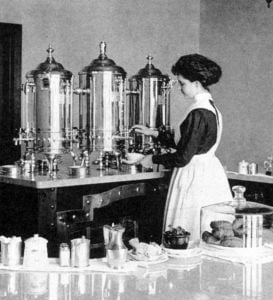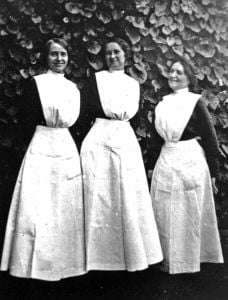Who were the Harvey Girls?
There wouldn’t have been a Harvey Girl without Fred Harvey, the visionary entrepreneur who paved the way for civilized travel when the West was still wild.
Who were the Harvey Girls? In the words of humorist Will Rogers, they were women who “kept the West in food – and wives.”
More specifically, they were young, single, intelligent women who were also of “good character,” and, presumably, had the sort of sense of adventure that propelled them to unknown territory in the 1880s to work as waitresses. 
Their legacy: Helping to make travel in the West a lot more enjoyable by serving tasty meals in pleasant surroundings and bringing a touch of graciousness to a mostly unsettled land.
But there wouldn’t have been a Harvey Girl without Fred Harvey, the visionary entrepreneur who paved the way for civilized travel when the West was still wild. As a freight agent in the 1870s Harvey spent enough time traveling via train in an era before dining cars to experience first-hand the difficulty of finding good food. Roadhouses set up near the tracks offered limited fare of dubious quality and service ranging from indifferent to surly.
Recognizing a business opportunity, Harvey struck a deal with the Atchison, Topeka & Santa Fe Railway to operate a system of eateries along its rail lines. His first depot restaurant opened in Topeka, Kansas, in 1876. Within two years, he’d opened his first hotel/restaurant in Florence, Kansas. The foundation for what would grow into a hospitality empire was laid. By 1891, 15 Harvey House restaurants were in operation.
But Harvey not only created America’s first restaurant chain, he was a pioneer of cultural tourism. In the early 1900s, the Fred Harvey Company created an “Indian Department,” which commissioned artists and photographers to convey the exoticism of Indians in the Southwest. The images were printed on everything from menus to brochures to promote the mystique of Indian Country, and, not incidentally, Harvey’s tourist enterprises.
The company also employed Native Americans to demonstrate rug weaving, pottery, jewelry making and other crafts at his Southwest hotels. The sales of those items in Harvey’s stores influenced the design of native arts.
Taking the marketing approach even further, in 1926, the Harvey Company began offering “Indian Detours,” chauffeured interpretive tours in which guests at his Southwest hotels were ferried in comfortable Harvey Cars for one- to three-day excursions into Indian settlements in New Mexico and Arizona.
 The Harvey Girls were a signature component of Harvey’s success and one of his most enduring legacies. Placing ads in Midwestern and Eastern publications, he solicited women between the ages of 18 and 30 to travel west and work as waitresses in his restaurants. Other qualifications included being unmarried and “of good character.” The “girls” signed yearlong contracts and lived next to or in the Harvey Houses, under the close supervision of a Harvey Girl with the longest tenure. If they left before the year was up—the most common reason for doing so was marriage—they forfeited a portion of their base pay.
The Harvey Girls were a signature component of Harvey’s success and one of his most enduring legacies. Placing ads in Midwestern and Eastern publications, he solicited women between the ages of 18 and 30 to travel west and work as waitresses in his restaurants. Other qualifications included being unmarried and “of good character.” The “girls” signed yearlong contracts and lived next to or in the Harvey Houses, under the close supervision of a Harvey Girl with the longest tenure. If they left before the year was up—the most common reason for doing so was marriage—they forfeited a portion of their base pay.
Not only did these waitresses provide pleasant, efficient service, but in the early years of Harvey’s enterprise, at least, they were often the only single young women for miles around. That in itself would have been a draw, even if the food hadn’t been up to snuff.
The prototypical early uniform consisted of a long black dress (no more than 8 inches above the floor) overlaid with a starched white apron, black opaque stockings and black shoes. This 19th-century image was popularized in a 1946 namesake movie, The Harvey Girls, starring Judy Garland.
As passenger rail travel gave way to the automobile, Harvey’s enterprise switched gears and catered to the motoring public. At the time of his death in 1901, the Fred Harvey Company operated 47 restaurants, 15 hotels and 30 dining cars on the Santa Fe Railway. At the peak, the number of Harvey House restaurants numbered in the eighties.
The enterprise continued into the 1960s, with Harvey’s son, and later, his grandson, at the helm. In 1968, it was purchased by Amfac Parks & Resorts, which was renamed Xanterra Parks & Resorts in 2002.
Though most of the original Harvey Houses and hotels are gone, a few survive. Most notable are the El Tovar Hotel and Bright Angel Lodge on the South Rim of the Grand Canyon. One of the jewels of the National Park Lodges, El Tovar opened as a Harvey House in 1905. The Fray Marcos Hotel in nearby Williams, Ariz., built as a Harvey House in 1908, now houses a gift shop, offices, and the train depot for the Grand Canyon Railway & Hotel. The new hotel nearby reflects the style of the original. Both El Tovar and Bright Angel, along with the Grand Canyon Railway & Hotel, are operated by Xanterra.
How to Explore
Grand Canyon National Park Lodges provides the premier in-park lodging, managing six distinctly different lodges. From the El Tovar hotel, long considered the crown jewel of national park hotels, to Phantom Ranch, the only lodging on the floor of the canyon, you’ll find accommodations to help you get the most out of your visit to the Grand Canyon. You can also book rafting, railway, and motorcoach tours. For more information and reservations, visit grandcanyonlodges.com or call 888-297-2757.
For more travel experiences to Beautiful Places on Earth™ available from Xanterra Travel Collection® and its affiliated properties, visit xanterra.com/explore.